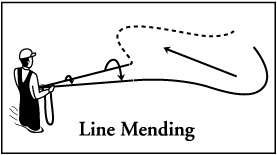Line Mending
Line mending is a repositioning of the line on the water so that its new position extends the fly’s drift. Plainly, mends are upstream (upwind) or downstream rod flips which reposition the line belly while it is adrift.
Mending is essential to many presentations; both dry and wet fly methods call for line mending. A simple flip of the wrist mends the line. Upstream flips tend to slow down the fly’s drift; likewise, downstream flips hasten the fly’s drift.
A stream’s diverse current speed causes the need for mending and determines the direction of the mend. For example, when the fly is in faster current than its line, a downstream mend extends the fly’s drift. On the other hand, when the fly is in a slower current than its line an upstream mend extends the fly’s drift. Since streams seldom have a uniform current, the angler is constantly confronted with mixed current speeds. Common sense determines the direction the line is mended.
An upstream mend repositions the line belly to float at the same position as the fly; hence mending lengthens the fly’s drift by preventing drag.
As you fish out a cast, constantly watch the fly and line position. As the fish’s relationship to the line changes, correct the line by mending it in the appropriate direction. Optimally, the mending goal is to keep the line, leader, and fly in a straight line. Mending retains this straight alignment.


© 2026 The Gale Group, Inc. All rights reserved.
© 2026 Perigee Learning LLC. All rights reserved.
LoveTheOutdoors.com is owned and operated by Advameg, Inc. © 2026 Advameg, Inc.
Camping Adventures • Dutch Oven Cooking • Sports Knots
Fly Tying • Freshwater Fishing • Fly Fishing

